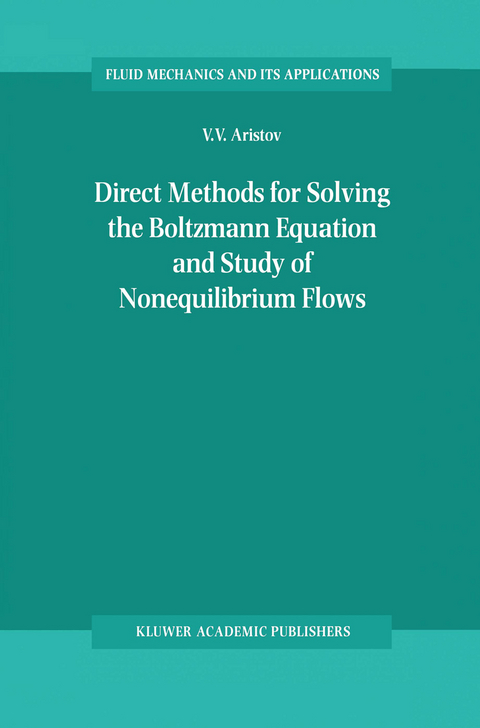
Direct Methods for Solving the Boltzmann Equation and Study of Nonequilibrium Flows
Springer-Verlag New York Inc.
978-1-4020-0388-2 (ISBN)
1 The Boltzmann Equation as a Physical and Mathematical Model.- 1.1 Different mathematical forms of the kinetic equation.- 1.2 Peculiarities of kinetic approach for describing physical properties.- 1.3 Formulation of problems and boundary conditions.- 1.4 The forms of the Boltzmann equations in some physical cases.- References.- 2 Survey of Mathematical Approaches to Solving the Boltzmann Equation.- 2.1 General notes on classification of methods.- 2.2 Methods combining analytical and numerical features. Some partial solutions.- 2.3 Approaches based on kinetic models.- 2.4 Numerical simulation methods.- 2.5 Direct simulation Monte Carlo methods.- 2.6 Methods of direct integration.- 2.7 Comparison of direct integration and direct simulation.- References.- 3 Main Features of the Direct Numerical Approaches.- 3.1 Discrete velocities and approximation in velocity space.- 3.2 Approximation in physical space. Finite-difference schemes and iterations.- 3.3 Splitting method.- 3.4 Finite volume scheme.- 3.5 Evaluation of the collision integrals by Monte Carlo technique.- 3.6 Quasi Monte Carlo technique.- References.- 4 Deterministic (Regular) Method for Solving the Boltzmann Equation.- 4.1 General features of the method.- 4.2 Approach to approximation of the collision integrals. Integration over velocity space.- 4.3 Exact evaluation of integrals over impact parameters.- 4.4 Approximation of the collision integrals by quadratic form with constant coefficients.- 4.5 Simplification for velocity space in the case of isotropic symmetry.- References.- 5 Construction of Conservative Scheme for the Kinetic Equation.- 5.1 Different definitions of conservativity.- 5.2 Conservative splitting method.- 5.3 Characteristics and advantages of the conservative schemes.- 5.4 Practical verificationof the method.- 5.5 Conservative method for gas mixtures.- References.- 6 Parallel Algorithms for the Kinetic Equation.- 6.1 Parallel implementation for the direct methods.- 6.2 Several parallel algorithms.- 6.3 Examples of parallel applications of the algorithms.- References.- 7 Application of the Conservative Splitting Method for Investigating Near Continuum Gas Flows.- 7.1 Some approaches to solving the Boltzmann equation for weakly rarefied gas.- 7.2 Asymptotic kinetic schemes approximating the Euler and Navier-Stokes equations.- 7.3 Schemes for flows at low Knudsen numbers.- References.- 8 Study of Uniform Relaxation in Kinetic Gas Theory.- 8.1 Spatially uniform (homogeneous) relaxation problem.- 8.2 Obtaining the test solutions for isotropic relaxation.- 8.3 Some examples of the relaxation problem solutions.- 8.4 Uniform relaxation for gas mixtures.- References.- 9 Nonuniform Relaxation Problem as a Basic Model for Description of Open Systems.- 9.1 Formulation of the problem and solution methods.- 9.2 Nonclassical behavior of macroscopic parameters.- 9.3 Behavior of the distribution function and macroscopic parameters.- 9.4 Possible entropy decrease.- 9.5 Some generalizations.- References.- 10 One-Dimensional Kinetic Problems.- 10.1 The problem of heat transfer.- 10.2 Shock wave structure.- 10.3 Flow in the field of an external force.- 10.4 Recondensation of a mixture in a force field.- References.- 11 Multi-Dimensional Problems. Study of Free Jet Flows.- 11.1 Possibilities of direct integration approaches for studying multi-dimensional problems.- 11.2 Formulation of the problem and numerical scheme.- 11.3 Free plane jet.- 11.4 Axisymmetric and three-dimensional free jet flows.- References.- 12 The Boltzmann Equation and the Description of Unstable Flows.- 12.1 Main notions.- 12.2 Boltzmann and Navier-Stokes description.- 12.3 Mathematical apparatus.- 12.4 Some results of numerical modelling..- References.- 13 Solutions of some Multi-Dimensional Problems.- 13.1 Unsteady problem of a shock wave reflection from a wedge.- 13.2 Solution for focusing of a shock wave.- 13.3 Study of flows in elements of cryovacuum devices.- 13.4 Flows in the vacuum cryomodulus.- 13.5 Two-component mixture flows with cryocondensation.- References.- 14 Special Hypersonic Flows and Flows with Very High Temperatures.- 14.1 Special hypersonic flows.- 14.2 Unsteady flows caused by a powerful point discharge of a finite gaseous mass.- 14.3 Asymptotic solution at t ? 0.- 14.4 Numerical analysis. Asymptotic solution at t ? ?.- 14.5 Scattering of impulsive molecular beam.- References.
| Reihe/Serie | Fluid Mechanics and Its Applications ; 60 |
|---|---|
| Zusatzinfo | XVII, 302 p. |
| Verlagsort | New York, NY |
| Sprache | englisch |
| Maße | 155 x 235 mm |
| Themenwelt | Naturwissenschaften ► Physik / Astronomie ► Mechanik |
| Technik ► Maschinenbau | |
| ISBN-10 | 1-4020-0388-9 / 1402003889 |
| ISBN-13 | 978-1-4020-0388-2 / 9781402003882 |
| Zustand | Neuware |
| Haben Sie eine Frage zum Produkt? |
aus dem Bereich


